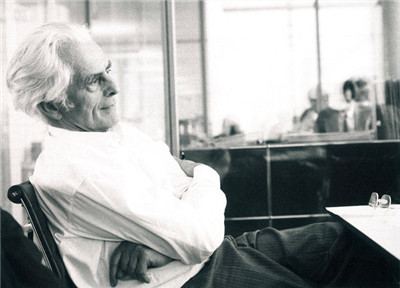In an announcement abruptly moved up after his death, the German architect Frei Otto on Tuesday was named the winner of the Pritzker Prize in recognition of his airy tentlike structures and other inventive feats of engineering.
е‘ЁдәҢпјҢеҫ·еӣҪе»әзӯ‘еёҲеј—йӣ·В·еҘҘжүҳ(Frei Otto)еӣ е…¶иҪ»зӣҲйҖҡйҖҸзҡ„еёҗзҜ·ејҸе»әзӯ‘з»“жһ„пјҢд»ҘеҸҠе…¶д»–зӢ¬ж ‘дёҖеёңзҡ„е·ҘзЁӢдҪңе“Ғиў«жҺҲдәҲжҷ®еҲ©е…№е…ӢеҘ–пјҢиҝҷйЎ№еҶіе®ҡжҳҜеңЁд»–еҺ»дё–еҗҺиҝ…йҖҹе…¬еёғзҡ„гҖӮ
Mr. Otto, 89, died in Germany on Monday, two weeks before he was to be named this yearвҖҷs laureate, the prize jury said. He is perhaps best known for roof canopies designed for the 1972 Olympic Games in Munich, admired for their blend of lightness and strength.
еҘҘжүҳдәҺе‘ЁдёҖеңЁеҫ·еӣҪеҺ»дё–пјҢдә«е№ҙ89еІҒпјҢжҷ®еҲ©е…№е…ӢеҘ–йЎ№иҜ„е®Ўеӣўз§°пјҢд»–жң¬еә”дәҺдёӨе‘ЁеҗҺиҺ·еҫ—иҜҘеҘ–гҖӮд»–жңҖи‘—еҗҚзҡ„дҪңе“ҒжҳҜдёә1972е№ҙж…•е°јй»‘еҘҘиҝҗдјҡи®ҫи®Ўзҡ„йЎ¶жЈҡпјҢе®ғ们既иҪ»зӣҲеҸҲжңүеҠӣпјҢеӣ жӯӨеӨҮеҸ—иөһиӘүгҖӮ

вҖңHe has embraced a definition of architect to include researcher, inventor, form-finder, engineer, builder, teacher, collaborator, environmentalist, humanist, and creator of memorable buildings and spaces,вҖқ the jury said in its citation.
вҖңд»–зӣёдҝЎпјҢе»әзӯ‘еёҲеә”еҪ“жҳҜз ”з©¶иҖ…гҖҒеҸ‘жҳҺиҖ…гҖҒеҪўејҸзҡ„еҸ‘зҺ°иҖ…гҖҒе·ҘзЁӢеёҲгҖҒе»әйҖ иҖ…гҖҒж•ҷеёҲгҖҒеҗҲдҪңиҖ…гҖҒзҺҜдҝқдё»д№үиҖ…гҖҒдәәж–Үдё»д№үиҖ…пјҢд№ғиҮід»Өдәәйҡҫеҝҳзҡ„е»әзӯ‘дёҺз©әй—ҙзҡ„еҲӣйҖ иҖ…пјҢвҖқиҜ„е®ЎеӣўеңЁиҜ„е®ЎиҜҚдёӯиҜҙйҒ“гҖӮ
The Pritzker is regarded as architectureвҖҷs highest honor and usually goes to a living architect. The committee said it was the first time that a winner had died before the announcement was made.
жҷ®еҲ©е…№е…ӢеҘ–жҳҜе»әзӯ‘еёҲзҡ„жңҖй«ҳиҚЈиӘүпјҢйҖҡеёёжҺҲдәҲе°ҡеңЁдәәдё–зҡ„е»әзӯ‘еёҲгҖӮиҜ„еҘ–委е‘ҳдјҡиҜҙпјҢиҺ·еҘ–еҗҚеҚ•е°ҡжңӘе…¬еёғпјҢиҺ·еҘ–иҖ…е·Із»Ҹжӯ»еҺ»пјҢиҝҷиҝҳжҳҜ第дёҖж¬ЎгҖӮ
Mr. Otto learned of his selection early this year when Martha Thorne, the prizeвҖҷs executive director, flew to Stuttgart to inform him of the juryвҖҷs choice. He was blind but otherwise in good health, the panel said. Mr. Otto was honored and surprised, according to Edward Lifson, a spokesman for the prize.
д»Ҡе№ҙе№ҙеҲқпјҢеҘҘжүҳе·ІзҹҘйҒ“иҮӘе·ұиҺ·еҘ–зҡ„ж¶ҲжҒҜпјҢиҜҘеҘ–йЎ№зҡ„жү§иЎҢе®ҳзҺӣиҺҺВ·зҙўжҒ©(Martha Thorne)еқҗйЈһжңәжқҘеҲ°ж–ҜеӣҫеҠ зү№пјҢжҠҠиҜ„委们зҡ„ж„Ҹи§Ғе‘ҠиҜүд»–гҖӮ委е‘ҳдјҡиҜҙпјҢд»–еҸҢзӣ®еӨұжҳҺпјҢдҪҶеҒҘеә·зҠ¶жҖҒиүҜеҘҪгҖӮиҜҘеҘ–йЎ№зҡ„еҸ‘иЁҖдәәзҲұеҫ·еҚҺВ·йҮҢеј—жЈ®(Edward Lifson)иҜҙпјҢеҘҘжүҳеҫ—зҹҘиҺ·еҘ–ж¶ҲжҒҜпјҢж„ҹеҲ°иҚЈе№ёе’ҢжғҠе–ңгҖӮ
вҖңIвҖҷve never done anything to gain this prize,вҖқ Mr. Otto was quoted as saying. вҖңPrizewinning is not the goal of my life. I try to help poor people, but what shall I say here вҖ” IвҖҷm very happy.вҖқ
д»–еј•иҝ°еҘҘжүҳзҡ„иҜқиҜҙвҖңжҲ‘д»ҺжқҘжІЎдёәиҝҷдёӘеҘ–иҖҢеҒҡиҝҮд»Җд№ҲпјҢжҷ®еҲ©е…№е…ӢеҘ–并дёҚжҳҜжҲ‘зҡ„дәәз”ҹзӣ®ж ҮгҖӮжҲ‘дёҖзӣҙеҠӘеҠӣеё®еҠ©з©·дәәпјҢдҪҶзҺ°еңЁжҲ‘иҜҘжҖҺд№ҲиҜҙе‘ўвҖ”вҖ”жҲ‘еҫҲй«ҳе…ҙвҖқгҖӮ
Mr. Otto may not have been a household name, but he was widely esteemed in the profession. Prominent architects had quietly pushed for him to receive the award for years.
еҘҘжүҳзҡ„еҗҚеӯ—жҲ–许并йқһ家喻жҲ·жҷ“пјҢдҪҶд»–еңЁиЎҢдёҡеҶ…е№ҝеҸ—е°Ҡ敬гҖӮеӨҡе№ҙжқҘпјҢи®ёеӨҡи‘—еҗҚе»әзӯ‘еёҲйғҪй»ҳй»ҳж”ҜжҢҒд»–иҺ·еҫ—иҜҘеҘ–гҖӮ
вҖңTime waits for no man,вҖқ said Peter Palumbo, the Pritzker chairman, in a statement, calling Mr. OttoвҖҷs death вҖңa sad and striking example of this truism.вҖқ
вҖңж—¶й—ҙдёҚзӯүдәәпјҢвҖқжҷ®еҲ©е…№е…ӢеҘ–дё»еёӯеҪјеҫ—В·её•е…°жіў(Peter Palumbo)еңЁдёҖйЎ№еЈ°жҳҺдёӯиҜҙпјҢд»–иҜҙеҘҘжүҳзҡ„еҺ»дё–вҖңжҳҜиҝҷдёҖзңҹзҗҶжӮІдјӨиҖҢжҳҫи‘—зҡ„дҫӢиҜҒвҖқгҖӮ
The announcement was originally to be made on March 23. The architect Frank Gehry was to award Mr. Otto the prize at a ceremony on May 15 at the New World Center in Miami. That will proceed as scheduled, with past Pritzker laureates speaking there about Mr. OttoвҖҷs life and work.
иҜҘеҘ–йЎ№жң¬еә”дәҺ3жңҲ23ж—Ҙе…¬еёғгҖӮ5жңҲ15ж—ҘпјҢе°Ҷз”ұе»әзӯ‘еёҲеј—е…°е…ӢВ·зӣ–йҮҢ(Frank Gehry)еңЁиҝҲйҳҝеҜҶзҡ„ж–°дё–з•ҢдёӯеҝғдёҫиЎҢзҡ„е…ёзӨјдёҠдёәеҘҘжүҳйўҒеҘ–гҖӮйўҒеҘ–зӨјд»Қе°ҶжҢүи®ЎеҲ’иҝӣиЎҢпјҢеұҠж—¶е°ҶжңүеҫҖд»»жҷ®еҲ©е…№е…ӢеҘ–иҺ·еҫ—иҖ…иҝӣиЎҢе…ідәҺеҘҘжүҳзҡ„з”ҹе№ідёҺдҪңе“Ғзҡ„и®Іжј”гҖӮ
Mr. Otto first became known for tent structures used as temporary pavilions at the Federal Garden Show in Germany and other events in the 1950s.
еҘҘжүҳжҳҜеңЁ20дё–зәӘ50е№ҙд»ЈжңҖеҲқдёәдәә们жүҖзҹҘпјҢеҪ“ж—¶д»–дёәеҫ·еӣҪзҡ„иҒ”йӮҰеӣӯжһ—еұ•зӯүжҙ»еҠЁи®ҫи®ЎдәҶеёҗзҜ·з»“жһ„зҡ„дёҙж—¶е»әзӯ‘гҖӮ
His large-scale roofs for the 1972 Olympics stadium in Munich, designed with GГјnter Behnisch, defied expectations, though the games were vastly overshadowed by the massacre of 11 Israeli athletes there by Palestinian terrorists.
1972е№ҙпјҢд»–дёҺз”ҳзү№В·зҸӯе°јеҘҮ(GГјnter Behnisch)еҗҲдҪңпјҢдёәж…•е°јй»‘еҘҘиҝҗдјҡеңәйҰҶи®ҫи®ЎдәҶжҢ‘жҲҳдј з»ҹзҡ„еӨ§еһӢйЎ¶жЈҡпјҢ然иҖҢйӮЈе№ҙзҡ„еҘҘиҝҗдјҡиў«з¬јзҪ©еңЁ11еҗҚд»ҘиүІеҲ—иҝҗеҠЁе‘ҳйҒӯеҲ°е·ҙеӢ’ж–ҜеқҰжҒҗжҖ–еҲҶеӯҗжқҖе®ізҡ„йҳҙеҪұд№ӢдёӢгҖӮ
Mr. Otto often designed in collaboration with others, collaborating with Shigeru Ban on JapanвҖҷs pavilion for the 2000 Hannover Expo in Germany and with Rolf Gutbrod on the West German pavilion at the Montreal Expo of 1967.
еҘҘжүҳз»ҸеёёеҗҢе…¶д»–дәәеҗҲдҪңиҝӣиЎҢи®ҫи®ЎпјҢд»–дёҺеқӮиҢӮ(Shigeru Ban)еҗҲдҪңпјҢи®ҫи®ЎдәҶ2000е№ҙеҫ·еӣҪжұүиҜәеЁҒдё–з•ҢеҚҡи§ҲдјҡдёҠзҡ„ж—Ҙжң¬йҰҶпјҢдёҺзҪ—е°”еӨ«В·еҸӨзү№еёғзҪ—еҫ·(Rolf Gutbrod)еҗҲдҪңи®ҫи®ЎдәҶ1967е№ҙи’ҷзү№еҲ©е°”дё–з•ҢеҚҡи§ҲдјҡдёҠзҡ„иҘҝеҫ·йҰҶгҖӮ
Born in Siegmar, outside Chemnitz in eastern Germany, Mr. Otto grew up in Berlin. He designed glider planes as a hobby, fascinated by the structural forces at work when thin membranes are stretched over light frames.
еҘҘжүҳеҮәз”ҹдәҺеҫ·еӣҪдёңйғЁејҖе§Ҷе°јиҢЁеҹҺеӨ–зҡ„иҘҝж јй©¬е°”пјҢеңЁжҹҸжһ—й•ҝеӨ§гҖӮд»–зҲұеҘҪи®ҫи®Ўж»‘зҝ”жңәпјҢиҝ·жҒӢз»“жһ„зҡ„еҠӣйҮҸпјҢе–ңж¬ўзәӨз»Ҷзҡ„и–„иҶңеңЁиҪ»зӣҲзҡ„з»“жһ„ж”Ҝж’‘дёӢдјёеұ•зҡ„ж ·еӯҗгҖӮ
During service as a pilot in the Luftwaffe during World War II, he was captured near Nuremberg, Germany, and spent two years as a prisoner of war near Chartres in France, where he worked as a camp architect, learning to build various structures with the minimal materials available.
вҖңдәҢжҲҳвҖқжңҹй—ҙпјҢд»–еңЁзәізІ№з©әеҶӣдёӯжӢ…д»»йЈһиЎҢе‘ҳпјҢеңЁзәҪдјҰе Ўйҷ„иҝ‘иў«дҝҳпјҢеңЁжі•еӣҪжІҷзү№е°”пјҢд»–еәҰиҝҮдәҶдёӨе№ҙжҲҳзҠҜз”ҹж¶ҜпјҢеңЁжҲҳдҝҳиҗҘжӢ…д»»е»әзӯ‘еёҲпјҢеӯҰдјҡдәҶдҪҝз”ЁжүӢеӨҙжһҒдёәз®ҖеҚ•зҡ„жқҗж–ҷе»әйҖ дёҚеҗҢзҡ„е»әзӯ‘з»“жһ„гҖӮ
After the war Mr. Otto returned to study architecture at the Technical University of Berlin, where he earned a doctorate in civil engineering in 1954.
жҲҳеҗҺпјҢеҘҘжүҳеӣһеҲ°жҹҸжһ—жҠҖжңҜеӨ§еӯҰеӯҰд№ е»әзӯ‘пјҢ1954е№ҙиҺ·еҫ—еңҹжңЁе·ҘзЁӢеҚҡеЈ«еӯҰдҪҚгҖӮ
In a clear reaction to the heavy columned buildings commissioned under the Third Reich, Mr. OttoвҖҷs work was lightweight, democratic, low-cost and sometimes temporary.
еҘҘжүҳзҡ„дҪңе“ҒиҪ»е·§гҖҒе№іж°‘еҢ–гҖҒдҪҺжҲҗжң¬пјҢжңүж—¶жҳҜдёҙж—¶е»әзӯ‘пјҢиҝҷжҳҫ然жҳҜеҜ№з¬¬дёүеёқеӣҪж—¶жңҹеёғж»ЎйҮҚйҮҚеңҶжҹұзҡ„е»әзӯ‘йЈҺж јзҡ„дёҖз§ҚеҸҚжӢЁгҖӮ
After a trip through the United States, where he viewed the work of Frank Lloyd Wright, Eero Saarinen, Ludwig Mies van der Rohe and others, Mr. Otto became a freelance architect in 1952, opening an office in Berlin. He went on to found several institutions dedicated to lightweight structures.
еҺ»зҫҺеӣҪж—…иЎҢж—¶пјҢд»–еҸӮи§ӮдәҶеј—е…°е…ӢВ·зҪ—дјҠеҫ·В·жҖҖзү№(Frank Lloyd Wright)гҖҒеҹғзҪ—В·жІҷйҮҢе®Ғ(Eero Saarinen)гҖҒи·Ҝеҫ·з»ҙж јВ·еҜҶж–ҜВ·еҮЎВ·еҫ·В·зҪ—(Ludwig Mies van der Rohe)зӯүдәәзҡ„дҪңе“ҒпјҢ1952е№ҙпјҢеҘҘжүҳжҲҗдәҶиҮӘз”ұе»әзӯ‘еёҲпјҢеңЁжҹҸжһ—ејҖдәҶдәӢеҠЎжүҖгҖӮе…¶еҗҺеҸҲејҖдәҶиӢҘе№ІиҮҙеҠӣдәҺиҪ»еһӢе»әзӯ‘зҡ„жңәжһ„гҖӮ
He was inspired by вҖңnatural phenomena вҖ” from birdsвҖҷ skulls to soap bubbles and spidersвҖҷ webs,вҖқ the British architect Richard Rogers, a member of the Pritzker jury and a past laureate, said in a statement prepared before Mr. OttoвҖҷs death.
жҷ®еҲ©е…№е…ӢеҘ–иҜ„委гҖҒиҜҘеҘ–жӣҫз»Ҹзҡ„еҫ—дё»вҖ”вҖ”иӢұеӣҪе»әзӯ‘еёҲзҗҶжҹҘеҫ·В·зҪ—жқ°ж–ҜеңЁдёҖд»ҪеҶҷдәҺеҘҘжүҳз”ҹеүҚзҡ„еЈ°жҳҺдёӯеҶҷйҒ“пјҢеҘҘжүҳзҡ„и®ҫи®ЎеҸ—еҲ°вҖңд»Һйёҹе„ҝзҡ„еӨҙйӘЁеҲ°иӮҘзҡӮжіЎе’ҢиңҳиӣӣзҪ‘зӯүиҮӘ然зҺ°иұЎвҖқзҡ„еҗҜеҸ‘гҖӮ
Mr. OttoвҖҷs work has been widely recognized. In 2006, for example, he won the 18th annual Praemium Imperiale prize for architecture, awarded by the Japan Art Association; in 2005 he received the Royal Gold Medal for architecture from the Royal Institute of British Architects.
еҘҘжүҳзҡ„и®ҫи®Ўе№ҝеҸ—еҘҪиҜ„гҖӮжҜ”еҰӮпјҢ2006е№ҙпјҢд»–жӣҫиҺ·еҫ—第18еұҠе№ҙеәҰж—Ҙжң¬зҡҮе®Өдё–з•Ңж–ҮеҢ–еҘ–пјҢиҜҘеҘ–йЎ№з”ұж—Ҙжң¬ж–ҮеҢ–еҚҸдјҡйўҒеҸ‘пјӣ2005е№ҙпјҢд»–иҺ·еҫ—иӢұеӣҪе»әзӯ‘зҡҮ家еҚҸдјҡйўҒеҸ‘зҡ„зҡҮ家е»әзӯ‘йҮ‘еҘ–гҖӮ
вҖңFrei Otto is one of the great architects and engineers of the 20th century,вҖқ Mr. Rogers said. вҖңHis work has inspired and influenced modern architecture, as we all learn to do more with less, and to trade monumental structures for economy, light and air.вҖқ
вҖңеј—йӣ·В·еҘҘжүҳжҳҜ20дё–зәӘзҡ„дјҹеӨ§е»әзӯ‘еёҲдёҺе·ҘзЁӢеёҲпјҢвҖқзҪ—жқ°ж–ҜиҜҙгҖӮвҖңд»–зҡ„дҪңе“ҒеҗҜеҸ‘并еҪұе“ҚдәҶзҺ°д»Је»әзӯ‘пјҢжҲ‘们йғҪеӨҡе°‘д»ҺдёӯеҸ—зӣҠпјҢд»–зҡ„дҪңе“Ғз”Ёз»ҸжөҺз®ҖзәҰе’ҢиҪ»зӣҲйҖҡйҖҸеҸ–д»ЈдәҶзәӘеҝөзў‘ејҸзҡ„жІүйҮҚгҖӮвҖқ













